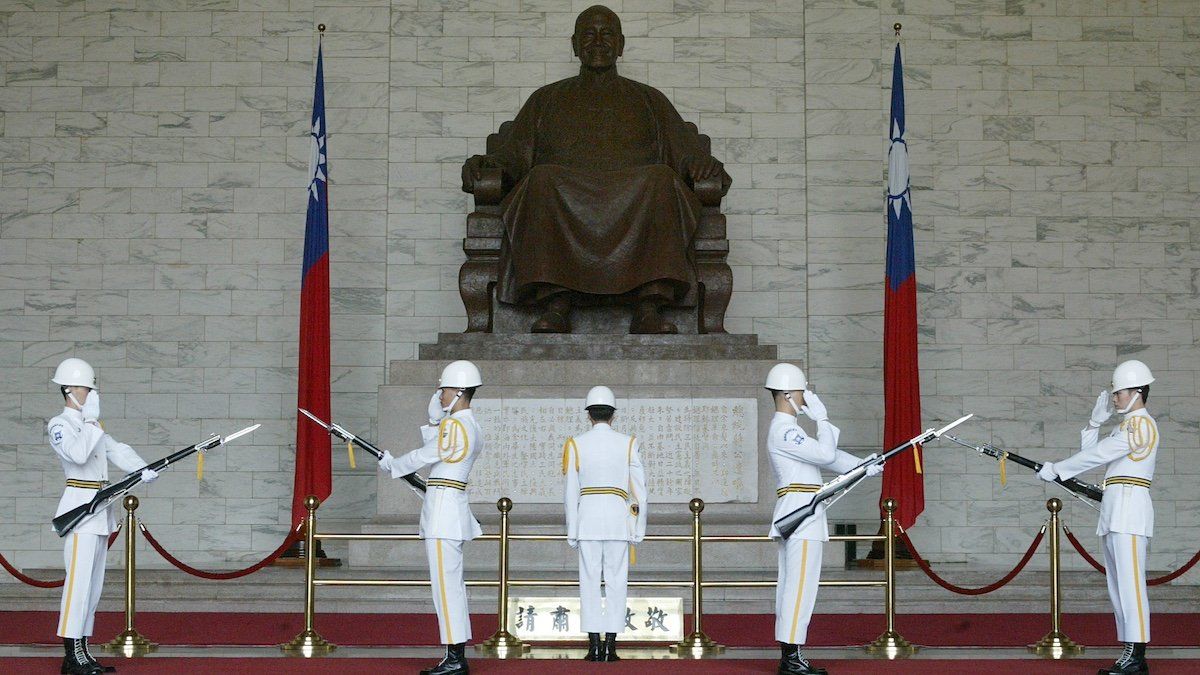Taiwan’s government has pledged accelerate efforts to remove over 700 statues of Chiang Kai-shek, the former leader responsible for Taiwan’s independence and decades of authoritarian rule.
Odd as it may sound to play down the country’s founding figure, the ruling Democratic Progressive Party sees removing the statues as a way to move symbolically beyond its painful past. The opposition Kuomintang or KMT – Chiang’s old party – is fighting to keep his image in places of prominence, particularly military institutions, and it’s not an idle debate: Chiang’s memory ties Taiwan’s political discourse to the mainland, and how the government treats his memorials resonates in Beijing.
The young warlord. Chiang rose to prominence in the chaos that followed the collapse of the Qing Dynasty in 1911. The KMT formed a provisional government but was quickly forced to hand power to Gen. Yuan Shikai, who soon died.
Powerful men carved out fiefdoms for themselves, while what remained of the KMT reorganized itself in the far southern city of Guangdong under its leader Sun Yat-sen. Chiang, who had served in the Imperial Japanese Army, took command of the KMT’s military academy in Whampoa in 1924. He and Sun saw military strength as the only avenue to reunite China and build a modern nation.
Backed by Soviet military advisors and bolstered in number by an alliance with the Chinese Communist Party, KMT forces trained for two years to strike northward. On the eve of war, however, Sun died. Chiang seized control and launched a bloody invasion of central and eastern China in July of 1926. By April of 1927, Chiang's forces had taken Shanghai, with approximately 700,000 people dead.
Rivalry with the Communists. With Shanghai secured, Chiang turned on his erstwhile allies and killed thousands of communists and suspected sympathizers.
Though the KMT would go on to take Beijing and nominally unify China in 1928, this so-called “Shanghai massacre” had effectively launched the country into another civil war. A young Mao Zedongretreated into the mountains of Jiangxi province to launch guerrilla attacks against the KMT, and the Northern Expedition did little to end warlordism.
Japanese ambitions. Across the Yellow Sea, Tokyo eyed Chiang’s unification efforts with unease. Japan had preyed upon China’s weakness to wrest away control of Taiwan in 1895 and Korea in 1905, and it controlled significant economic interests in the northern region of Manchuria. Just as the KMT began to find serious success in 1931, Japan invaded Manchuria.
Chiang offered little resistance and focused instead on purging the communists. By 1934, he had eliminated some 90% of their fighting strength, but Mao fled to the northwest on his Long March, where he re-established a base of operations in October 1935.
By then, Chiang’s subordinates had had enough. They launched a conspiracy to kidnap him in the city of Xi’an in late 1936 and forced him to agree to an anti-Japanese alliance with Mao. Months later, Japanese forces launched a full invasion of China.
Saved by Uncle Sam. Tokyo rapidly secured key coastal cities and pushed Chiang west into the mountains. President Franklin Roosevelt was alarmed but constrained by a US public that wanted no part in an overseas war, so he could only offer economic and political support to Chiang.
Part of that support included an oil embargo against Japan, which contributed to Tokyo’s ill-fated decision to launch surprise attacks against Pearl Harbor, Manila, and Hong Kong on Dec. 7, 1941. The US began sending Chiang billions of dollars of aid, and troops to fight in Burma in a costly effort to keep supply lines open. Chiang allegedly stole staggering quantities of this aid, leading US Gen. Joseph Stilwell to give him the nickname “Cash My Check.”
Downfall and flight. While KMT and allied troops were fighting a bloody but largely ineffective campaign against Japan, Mao and his communists were gathering strength for the wars to come. After the Japanese surrender in 1945, the US dispatched Gen. George Marshall to build a unity government between Mao and Chiang, but the two sides were in open warfare by 1947.
President Harry Truman was not ready to support the unpopular and corrupt Chiang, and the KMT’s forces quickly melted. On Dec. 7, 1949, Chiang evacuated his government to Taiwan, where he intended to regroup and launch a reconquest of the mainland.
A new identity? In Taiwan, Chiang imposed martial law and began a strategy of economic development to build a capable military-industrial base. He was joined by around two million nationalist troops, and around a million civilians fled the mainland between 1949 and 1955.
These new arrivals known as waishengren coalesced into a distinct — and privileged — Mandarin-speaking social class. They formed the core of Chiang’s government and economic reform strategy, in contrast to the majority Minnan- and Hakka-speaking indigenous population of Taiwan, who had few ties across the strait and suffered more under military rule.
But Chiang never came close to reconquering China, and as the country moved toward democratization following his death in 1975, intense debate has centered on Taiwan’s relationship to the mainland. Those with ties to Chiang’s government in the KMT see Taiwan as indelibly linked to China, even if they’ll never take back the mainland. Beijing sees the KMT as more sympathetic and pliable toward peaceful reunification because of that affinity.
Members of the ruling DPP party, including president-elect
William Lai, on the other hand, sometimes
question whether Taiwan would be better off essentially declaring itself
not China, and downplaying links with Chinese nationalist figures like Chiang. Beijing doesn’t see a way to negotiate a peaceful integration with leaders who don’t share Chiang’s view of a China that includes Taiwan as an integral part, which is why the symbolism of removing statues of Chiang will have real-world consequences.
